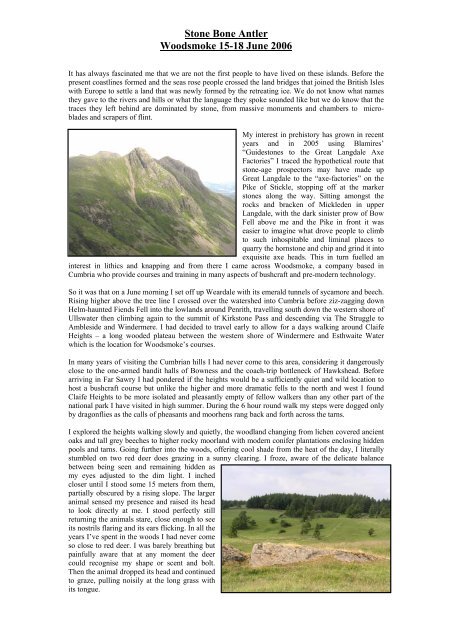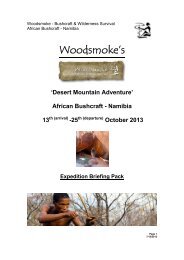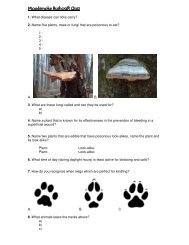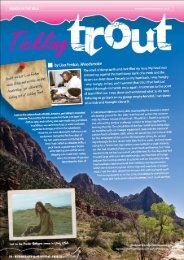Stone Bone Antler â Review - Woodsmoke
Stone Bone Antler â Review - Woodsmoke
Stone Bone Antler â Review - Woodsmoke
Create successful ePaper yourself
Turn your PDF publications into a flip-book with our unique Google optimized e-Paper software.
<strong>Stone</strong> <strong>Bone</strong> <strong>Antler</strong><strong>Woodsmoke</strong> 15-18 June 2006It has always fascinated me that we are not the first people to have lived on these islands. Before thepresent coastlines formed and the seas rose people crossed the land bridges that joined the British Isleswith Europe to settle a land that was newly formed by the retreating ice. We do not know what namesthey gave to the rivers and hills or what the language they spoke sounded like but we do know that thetraces they left behind are dominated by stone, from massive monuments and chambers to microbladesand scrapers of flint.My interest in prehistory has grown in recentyears and in 2005 using Blamires’“Guidestones to the Great Langdale AxeFactories” I traced the hypothetical route thatstone-age prospectors may have made upGreat Langdale to the “axe-factories” on thePike of Stickle, stopping off at the markerstones along the way. Sitting amongst therocks and bracken of Mickleden in upperLangdale, with the dark sinister prow of BowFell above me and the Pike in front it waseasier to imagine what drove people to climbto such inhospitable and liminal places toquarry the hornstone and chip and grind it intoexquisite axe heads. This in turn fuelled aninterest in lithics and knapping and from there I came across <strong>Woodsmoke</strong>, a company based inCumbria who provide courses and training in many aspects of bushcraft and pre-modern technology.So it was that on a June morning I set off up Weardale with its emerald tunnels of sycamore and beech.Rising higher above the tree line I crossed over the watershed into Cumbria before ziz-zagging downHelm-haunted Fiends Fell into the lowlands around Penrith, travelling south down the western shore ofUllswater then climbing again to the summit of Kirkstone Pass and descending via The Struggle toAmbleside and Windermere. I had decided to travel early to allow for a days walking around ClaifeHeights – a long wooded plateau between the western shore of Windermere and Esthwaite Waterwhich is the location for <strong>Woodsmoke</strong>’s courses.In many years of visiting the Cumbrian hills I had never come to this area, considering it dangerouslyclose to the one-armed bandit halls of Bowness and the coach-trip bottleneck of Hawkshead. Beforearriving in Far Sawry I had pondered if the heights would be a sufficiently quiet and wild location tohost a bushcraft course but unlike the higher and more dramatic fells to the north and west I foundClaife Heights to be more isolated and pleasantly empty of fellow walkers than any other part of thenational park I have visited in high summer. During the 6 hour round walk my steps were dogged onlyby dragonflies as the calls of pheasants and moorhens rang back and forth across the tarns.I explored the heights walking slowly and quietly, the woodland changing from lichen covered ancientoaks and tall grey beeches to higher rocky moorland with modern conifer plantations enclosing hiddenpools and tarns. Going further into the woods, offering cool shade from the heat of the day, I literallystumbled on two red deer does grazing in a sunny clearing. I froze, aware of the delicate balancebetween being seen and remaining hidden asmy eyes adjusted to the dim light. I inchedcloser until I stood some 15 meters from them,partially obscured by a rising slope. The largeranimal sensed my presence and raised its headto look directly at me. I stood perfectly stillreturning the animals stare, close enough to seeits nostrils flaring and its ears flicking. In all theyears I’ve spent in the woods I had never comeso close to red deer. I was barely breathing butpainfully aware that at any moment the deercould recognise my shape or scent and bolt.Then the animal dropped its head and continuedto graze, pulling noisily at the long grass withits tongue.
A thrill ran through me as I realised the deer were continuing to act naturally. Silently I watched themmove through the clearing, heads down, tails flicking, the afternoon sun falling in shades of greenthrough the leaves. I decided to try to get closer and looked at the ground to pick out a path across themossy rocks and twigs. I was torn between watching the animals and watching my feet to ensure that Imade as little sound as possible. My heart began to beat faster as the adrenaline rose, a hunting instinct– surely an atavistic resurgence from our deep past - awakening within me. As I climbed the slope tothe clearing I crouched low to make as little silhouette as possible, trying to keep to the cover of a birchtree that offered the only blind between me and the deer. As I did so a twig cracked beneath my bootand the larger animal raised its head in my direction, looked and ran in one swift fluid movement. Thesmaller animal, startled by the disturbance followed and both crashed through the woods, their whitetails disappearing into the gloom.The heat of the late afternoon hit me again asI left the woods and made my way back toFar Sawry between high stone walls andforgotten quarry’s where ash and rowanclung to the rocks. Approaching the SawryHotel down a quiet lane a robin flittedthrough the hedge and I noticed a family ofjackdaw’s peeping out of the broken windowof a derelict house but they were not makingas much noise as the group of people stoodin the garden of the hotel. There’s nothing asincongruous as identikit-bushcrafter’s stoodaround in matching Tilly Hats, Magnumboots and Swandri smocks swapping storiesof their exploits. As I sat reading my mapand drinking my beer I was relieved when this group were taken to the Axe Workshop and weregradually replaced by my fellow students on the <strong>Stone</strong> <strong>Bone</strong> <strong>Antler</strong> course. When all were present weparked our cars and loaded our gear into the <strong>Woodsmoke</strong> landrovers and in the evening light droveback up the rocky tracks of Claife Heights to the base camp where the course would be taught.Beneath large mature beech trees a parachute canopy had beenerected and beneath that a wood fire burned. After pitching ourtents and basha’s on the slope of the hill we returned to themain camp and sat round the fire. The students and<strong>Woodsmoke</strong> staff introduced themselves and the diversity ofexperience and background became apparent, people who hadsome experience of primitive technology and archaeology andothers who had none. All seemed to have a genuine desire tolearn. <strong>Woodsmoke</strong> founders Lisa Fenton and Ben McNutt werepresent, as well as instructor Anthony Lamacraft. The coursewas lead by guest instructor Werner Pfiefer, a tall Namibian ofGerman extraction who with his long hair and beard resembledone of the Aesir, or maybe the desert ecologist Liet-Kynes fromFrank Herbert’s “Dune”. Werner’s stories of the Namibianbush would be one of the lasting memories of the course but Ihad risen early and spent the day walking so as the embersglowed and the pockets of chatter died away I left the fire andwent back to my camp to sleep.Woken early by birds I dressed and made my way to the main camp. All was quiet and I was consciousthat in the nearby woods people were still sleeping. I lay and lit the fire and quietly helped myself to atin of pears as I sat looking at the flames and wondered how the course would begin. 9.00am found thestudents sat in a circle around Werner as he explained the basics of flint-knapping and examples ofarrowheads and blades were passed around the group. It was explained that to flake flint from the corethe hammerstone must strike at an angle of less than 90-degree’s and that the strike surface must beflat, any blow falling on ridges would not produce the conchoidal fracture that caused the flint to flake.Whilst the instruction was clear and informative it was kept short and the focus was on students gainingthe skills by practical experimentation. Armed with our raw flint cores, hammer-stones, abraders and ablue tarp to gather the waste we spread out across the clearing and began to knap.The first obstacle was cracking open the large flint cherts to produce a working surface. Taking a largehammer stone in one hand and the chert in the other I cracked them together, harder and harder untilthe flint nodule shattered in a shower of dust and splinters. As I got used to the knapping action I began
to break off large flakes from the core. Some had hinged or step terminations but others flaked off withexquisitely sharp edges. As the morning wore on the clash of rock against rock gave way to a musicalmetallic ting-ting of flaking flint which echoed around the woods.After a couple of hours of knapping I hadamassed a sizeable collection of workableflakes and had begun to come to grips with theart of thinning the flint into a bi-facial piece andin the afternoon the technique of pressureflaking with a copper point was demonstrated.Using a copper bit fixed into a wooden handleprecise pressure can be applied to small areasallowing the flint to be notched or shaped.Using this technique I was able to producesome crude arrowheads and points butWerner’s story of how a friend had produced afunctional fishhook using this method seemedonly to highlight how much we had to learn.Throughout the course Werner, Ben, Lisa andAnthony would mingle among the students, offering hints and tips, correcting bad technique and takingtime to teach the skills and impart knowledge. The midsummer light lingered as I knapped long into theevening before falling to sleep full with cake.On the second day the first project was to make a small pumpdrill– an elegantly simple device for drilling into wood, bone orsoft stone using a flint bit. The motion of the drill comes from atwisted cord wrapped round the shaft and powered by a smallboard slotted over the shaft. A circular plate of softer stone, inthis case slate, fitted over the shaft and wedge close to thecutting point provided stability to the drill.Having cut and shaped the wooden pieces I began to peck andchip the irregular slice of slate into a circle. This done a holewas pecked in the centre with a small flint and further enlargedby rasping the hole with a larger piece of flint once the slate hadbeen pierced. With some small alterations the pump-drill wasready to fit together with a small flint point lashed into the shaftto form the working bit. Some corded thread was used to propelthe drill and with some practice and a steady hand the drill easilybore through wood and bone.In the afternoon we began to work with bone and antler. Werner demonstrated a technique for cutting aneedle from an antler roll or a length of bone and with this in mind I returned to my tarp and beganscrapping antler with flint. Having only ever used power tools and steel chisels on antler it soonbecame apparent that this was going to be a long and laborious process. I sat in the soft brown leaf litterscraping the antler with my flint burin while the ache in my arms and back told me that there must bean easier and more efficient way to do this. I was missing the firm working platform that a viceprovides so using a heavy stick as a mallet I hammered a large flint flake into the edge of an up-rightlog. With the flake firmly embedded I was able to knap the protruding edge into a series of jagged,saw-toothed points – holding the antler in my right hand and leaning on the log with my left a muchharder and efficient scraping action could beachieved. This worked better and the groovein the antler became larger and deeper untilfired by my invention I failed to concentrateand found that my neolithic lathe cut thumbsas well as it cut antler. With some efficientdoctoring from Ben my thumb was soonbandaged and I returned to my work.Whilst this was going on Werner andAnthony had prepared some birch bark fromwhich they were to extract tar. Pre-moderncultures needed glues and adhesives and wereable to produce them from animal and fishmaterial, the resin from coniferous trees and
also birch bark. The bark was packed tightly intoan iron pot which was then place upside downonto a large flat stone. The rim of the pot wassealed with clay and only a small gap left toallow the distilled tar to run off. A fire was litand under this heat the tightly packed birch barkreleased its tar, which was then collected in anold tin can. With some further heating to burn offany gases and impurities the tar was ready foruse. How did pre-modern societies with noaccess to iron pots and tin cans produce this veryuseful resource? A pecked stone dish or a claypot could have been used as a receptacle andmaybe a small chamber of flat stones fixed andsealed with clay could have been used to pack the bark into. Like many aspects of prehistory there areseveral possible solutions but no definitive answer.I returned to my work with the antler needle and reflected on how such a simple, everyday object in themodern world took so much time and energy to create by hand. The process of design and manufactureof an antler or bone needle provided prehistoric peoples with the means to sew skins into clothes,water-bags or boats - allowing expansion into hostile environments and the ability to tap furtherresources. In a modern world where it is possible to live ones life with no heed how the resources weuse are procured and sustained such a simple object provided a tangible link to an older and morethoughtful chapter of human history.On the last day we sat in the familiar semi-circle in front ofWerner and looked at an impressive collection of harpoonheads made from bone and antler. Having spent many hoursand much blood and sweat the previous day making only athin groove in a piece of red deer antler I didn’t fancy mychances of using flint to fashion a harpoon head. So it was tosome relief that Werner handed out small junior-hacksawsand with minimal instruction but maximum inspiration set usoff on our final project of the course.I was able to adapt my flint lathe of the previous day to act asa useful workbench and commenced to saw, I was stillsawing when Werner looked over my shoulder andcommented that the piece of antler I was working on waslarge enough to hunt whales and that I should scale it down.Having succumbed to the stone-age version of Big KnifeSyndrome I began to work on a smaller piece but soon foundthat even with a hacksaw antler proved a very tough andawkward material to cut. With the red deer antler cut into a4-inch length with a semi-circular profile I rasped the softer porous marrow from the middle on themulti-use neolithic lathe and marked out the barbs ready for sawing.The form and function of any object is closely related and as Iworked with the antler I realised how the modern mind,conditioned by industrial production thinks of tools, especiallycutting tools as uniformly straight and flat. Working thenaturally curved antler piece into a harpoon head called notonly for an appreciation of the task the harpoon would becalled to do but also an understanding of the characteristicsand qualities of the material. Would the antler harpoon head beany less efficient for having a slight convexity? It may offendthe sensibility of a modern eye used to the precise forms ofmetal tools but would our stone-age ancestors have minded aslong as it served the purpose it was intended for?The course ended too soon in a blaze of activity and a seasonalstorm that beat down on the parachute. The camp was struckand the fire extinguished while Anthony cheerfully pimped hisnew range of ventile smocks, a prototype of which hehappened to be wearing when the weather broke. Many of the
students had pieces they had made during the course, ranging from needles and arrowheads to adzesand full length spears and harpoons. Whilst there was certainly opportunity to do this the aspect of thecourse that I found most valuable was the chance to shed the layers of modernity that colour ourjudgement and have the chance to think like a pre-modern person. Reading is no substitute for doingand it is not until you are actually striking the core with the hammerstone or attempting to fashion atool to perform a specific task that the reality of how self-sufficient and capable our ancestors had to bebecomes evident. This was the real lesson of <strong>Stone</strong> <strong>Bone</strong> <strong>Antler</strong> – a re-introduction to the thoughtprocesses and creativity that signify humanity but which the modern world does so much to dull.I would like to thank Ben, Lisa, Werner and all the <strong>Woodsmoke</strong> instructors for providing such awelcoming environment to learn these skills, their good humour and knowledge were given generouslyand made the weekend enjoyable and rewarding. And if in the quiet of the evening the ker-ching of slotmachines drifted over Windermere I couldn’t hear it for the hoot of tawny owls and the cries of thewoodcock.Chris WaltonFurther Reading“Prehistoric Rock Art of Cumbria” - Stan Beckensall“Prehistoric Rock Art of County Durham, Swaledale and Wensleydale” – Stan Beckensall & TimLaurie“Prehistoric Rock Art of Northumberland” - Stan Beckensall“Guidestones to the Great Langdale Axe Factories” – Gabriel M Blamires“The Langdales – Landscape & Prehistory in a Lakeland Valley” – Mark Edmonds“Flintknapping” – John C Whittaker







